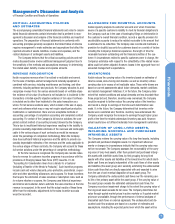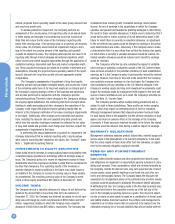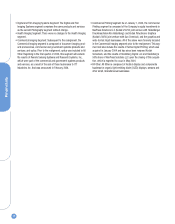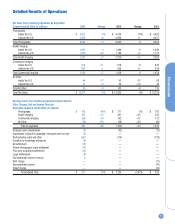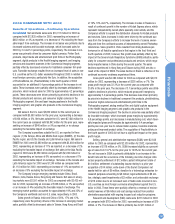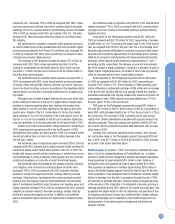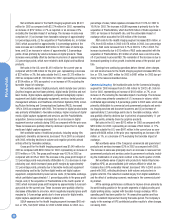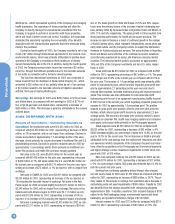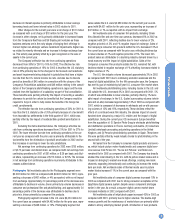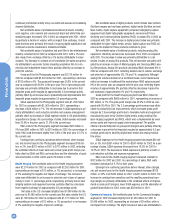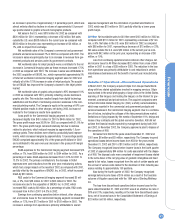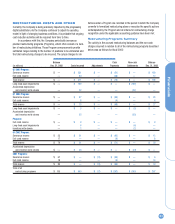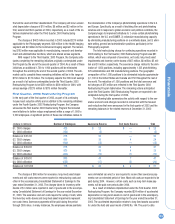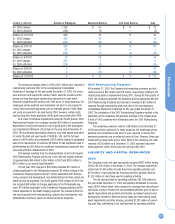Kodak 2003 Annual Report Download - page 17
Download and view the complete annual report
Please find page 17 of the 2003 Kodak annual report below. You can navigate through the pages in the report by either clicking on the pages listed below, or by using the keyword search tool below to find specific information within the annual report.
Financials
17
Gross profit for the Commercial Imaging segment for 2003
decreased $25 million, or 6%, from $449 million for 2002 to $424 million
for 2003. The gross profit margin was 27.2% for 2003 as compared with
30.8% for 2002. The decrease in the gross profit margin of 3.6 percent-
age points was attributable to: (1) an increase in manufacturing cost,
which negatively impacted gross profit margins by approximately 2.1 per-
centage points, primarily as a result of moving certain manufacturing
processes to new facilities during 2003, (2) declines attributable to
price/mix, which reduced gross profit margins by approximately 1.3 per-
centage points primarily due to declining contributions from traditional
graphic arts products for the reasons outlined above, and (3) unfavorable
exchange, which negatively impacted gross profit margins by 0.2 percent-
age points.
SG&A expenses for the Commercial Imaging segment increased $13
million, or 7%, from $194 million for 2002 to $207 million for 2003. The
increase in SG&A expense was primarily due to the impact of unfavorable
exchange, which accounted for $7 million of the increase, and an increase
in the benefit rate. As a percentage of sales, SG&A expenses remained
constant at 13.3% for both years.
R&D costs for the Commercial Imaging segment decreased $12 mil-
lion, or 19%, from $63 million for 2002 to $51 million for 2003. As a per-
centage of sales, R&D costs decreased from 4.3% in 2002 to 3.3% in
2003. The decline was primarily related to a decrease of approximately $9
million in ENCAD Inc.’s R&D spending in 2003 as compared with 2002.
Earnings from continuing operations before interest, other charges,
net, and income taxes for the Commercial Imaging segment decreased
$26 million, or 14%, from $192 million in 2002 to $166 million in 2003.
The decrease in earnings from operations is primarily attributable to the
reasons outlined above.
NexPress, the unconsolidated joint venture between Kodak and
Heidelberg in which the Company has a 50% ownership interest, contin-
ues to increase unit placements of the NexPress 2100 Digital Production
Color Press despite a weak printing market, with good customer accept-
ance.
On February 9, 2004, the Company announced its intent to sell the
assets and business of the Remote Sensing Systems operation, including
the stock of Kodak’s wholly owned subsidiary, Research Systems, Inc.,
collectively known as RSS, to ITT Industries for $725 million in cash. RSS,
a leading provider of specialized imaging solutions to the aerospace and
defense community, is part of the Company’s commercial and government
systems’ operation within the Commercial Imaging segment and its cus-
tomers include NASA, other U.S. government agencies, and aerospace and
defense companies. Kodak’s RSS operation had sales in 2003 of approxi-
mately $425 million. The sale of RSS is expected to result in an after-tax
gain of approximately $390 million. Taking into account both the after-tax
gain on the sale and the loss of operational results of RSS, the Company
expects that the sale will positively impact earnings by approximately
$1.31 per share in 2004. The after-tax gain and expected impact to earn-
ings per share for 2004 as a result of the RSS sale excludes the potential
impacts from any settlement or curtailment gains or losses that may be
incurred in connection with the Company’s pension and postretirement
benefit plans, as these amounts are not currently determinable. The
Company is currently evaluating whether the sale of RSS will be account-
ed for as a discontinued operation beginning in the first quarter of 2004 in
accordance with SFAS No. 144, "Accounting for the Impairment or
Disposal of Long-Lived Assets."
On March 8, 2004, the Company announced that it had agreed with
Heidelberger Druckmaschinen AG (Heidelberg) to purchase Heidelberg’s 50
percent interest in NexPress, a 50/50 joint venture of Kodak and
Heidelberg that makes high-end, on-demand digital color printing sys-
tems, and the equity of Heidelberg Digital LLC, a leading maker of digital
black-and-white variable-data printing systems. Kodak also will acquire
NexPress GmbH, a German subsidiary of Heidelberg that provides engi-
neering and development support, and certain inventory, assets, and
employees of Heidelberg’s regional operations or market centers. The
Company will not pay any cash at closing for the businesses being
acquired. Under the terms of the acquisition, Kodak and Heidelberg agreed
to use a performance-based earn-out formula whereby Kodak will make
periodic payments to Heidelberg over a two-year period, if certain sales
goals are met. If all sales goals are met during the next two calendar
years ending December 31, 2005, the Company will pay a maximum of
$150 million in cash. Additional payments may also be made if certain
sales goals are met during a five-year period following the closing of the
transaction. This acquisition, which is expected to close in May 2004,
advances the Company’s strategy of diversifying its business portfolio, and
accelerates its participation in the digital commercial printing industry.
The Company expects this acquisition to incrementally increase revenue
by approximately $175 million over the remainder of 2004. The impact of
these acquisitions to 2004 net earnings can not be accurately estimated
until the Company completes the acquisition.
Other Net worldwide sales for All Other were $95 million for 2003 as
compared with $103 million for 2002, representing a decrease of $8 mil-
lion, or 8%. Net sales in the U.S. were $44 million in 2003 as compared
with $53 million for 2002, representing a decrease of $9 million, or 17%.
Net sales outside the U.S. were $51 million in the current year as com-
pared with $50 million in the prior year, representing an increase of $1
million, or 2%.
SK Display Corporation, the OLED panel manufacturing joint venture
between Kodak and Sanyo, supplies OLED screens to the Company for its
digital camera manufacturing, and continues to focus on improving manu-
facturing yields. Kodak supplies OLED chemicals and materials to SK
Display, and has created a new generation of chemistry that is currently
being tested.
Loss from continuing operations before interest, other charges, net,
and income taxes for All Other increased $50 million from a loss of $28
million in 2002 to a loss of $78 million in 2003. Increased levels of invest-
ment for the Company’s display business primarily drove the increase in
the loss from operations.
Results of Operations— Discontinued Operations
Earnings from discontinued operations were $.09 per basic and diluted
share for 2003, as compared with a loss from discontinued operations for
2002 of $.08 per basic and diluted share.
During the first quarter of 2003, the Company reversed a tax reserve
of $15 million through discontinued operations. The reversal of the tax
reserve was triggered by the Company’s repurchase of certain properties
that were initially sold in connection with the 1994 divestiture of Sterling


